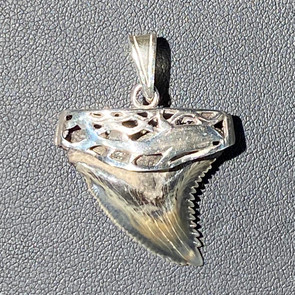Description
This jaw belonged to a Hemipristis serra which is a genus of weasel shark, family Hemigaleidae. It contains one extant species, the snaggletooth shark (H. elongata), as well as several extinct species.
Hemipristis has two distinct type of teeth in each section of its jaw. The ones on the upper jaw act like knives, cutting through the flesh of the prey, while the pointed ones on the bottom act like forks, spearing the prey and holding it down.
While today's snaggletooth shark is not very large or dangerous ranging up to 7' in length, Hemipristis serra, which lived in the Atlantic Ocean during the Oligocene and Miocene period, was considerably larger than its modern-day relative measuring up to 21' in length, and had much larger teeth. Marks made by the teeth of H. serra are often found on the bones of the manatee Metaxytherium leading some scientists to hypothesize that H. serra specialized in preying on these sirenians.
The unusual teeth of Hemipristis serra are highly prized by collectors because they are often found in sediments in Southern Florida that yield extremely colorful fossil shark teeth. Their outstandingly large serrations make it a favorite and unique collectible fossil.
This jaw was professionally reconstructed by a master jaw and skull preparer. The teeth are all fossilized and were collected in FL. The skull is of a modern Snaggle-toothed shark. The dentition is anatomically correct based on extensive research and relevant literature. This jaw features three rows of perfect quality teeth.
Dimensions: 11" L x 7 1/2" W x 5 1/2" D
Provenance: Venice, FL
Age: Miocene (23-5.3 MYA)
Type: Actual specimen- one only













